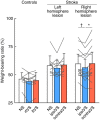Effects of Galvanic Vestibular Stimulation on Visual Verticality and Standing Posture Differ Based on the Polarity of the Stimulation and Hemispheric Lesion Side in Patients With Stroke
- PMID: 34858316
- PMCID: PMC8631773
- DOI: 10.3389/fneur.2021.768663
Effects of Galvanic Vestibular Stimulation on Visual Verticality and Standing Posture Differ Based on the Polarity of the Stimulation and Hemispheric Lesion Side in Patients With Stroke
Abstract
Introduction: There is growing evidence supporting the relationship of vertical misperception and poor balance control with asymmetrical standing posture in patients with stroke. Although the vestibular system has been shown to be responsible for vertical misperception and balance disorders, the effect of galvanic vestibular stimulation (GVS) on both vertical misperception and postural asymmetry after stroke remains elusive. The aim of this study was to investigate the effects of GVS on visual verticality and postural asymmetry after stroke and to clarify whether the effects differ depending on the polarity of the stimulation and hemispheric lesion side. Methods: We measured the subjective visual vertical (SVV) and body weight distribution on each foot in an upright stance in 24 patients with a hemispheric stroke (10 with a left hemisphere lesion and 14 with a right hemisphere lesion) and nine age-matched healthy controls. During the measurements, bipolar GVS (1.5 mA) was applied over the bilateral mastoid processes in three stimulation conditions: contralesional-anodal and ipsilesional-cathodal vestibular stimulation, ipsilesional-anodal and contralesional-cathodal vestibular stimulation, and no stimulation. To examine whether GVS modulates visual verticality and standing posture, SVV and weight-bearing in the three conditions were analyzed. Results: During no stimulation, the SVV deviated to the contralesional side in patients with a right hemisphere lesion, while more weight-bearing was observed on the ipsilesional limb than on the contralesional limb in both patient groups than in the controls. The SVV was modulated by reversing the polarity of GVS in all the groups when the cathodal stimulus side was either ipsilateral or contralateral to the lesion while the ipsilesional-cathodal vestibular stimulation reduced weight-bearing asymmetry in only the patients with a right hemisphere lesion. Conclusions: These findings demonstrate that the effects of GVS on the SVV and standing posture differ depending on the polarity of GVS and the hemispheric lesion side. Patients with a right hemisphere lesion have difficulty maintaining their preferred standing posture under visual verticality modulation evoked by GVS. The application of GVS may clarify whether the vestibular system has neural redundancy after stroke to suppress any effects of the stimulation, including modulation of the visual verticality, on balance.
Keywords: cerebrovascular disorder; hemiparesis; postural balance; subjective visual vertical; vestibular control.
Copyright © 2021 Tohyama, Kondo and Otaka.
Conflict of interest statement
The authors declare that the research was conducted in the absence of any commercial or financial relationships that could be construed as a potential conflict of interest.
Figures


References
LinkOut - more resources
Full Text Sources

